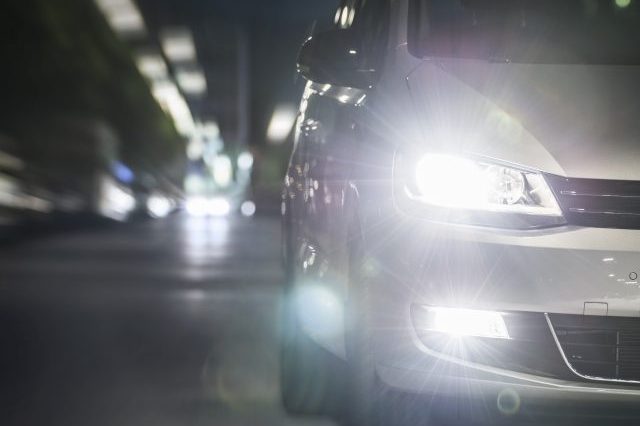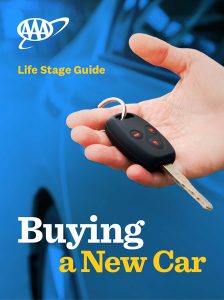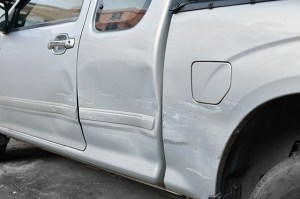Drivers are increasingly complaining about the intense LED headlight glare that comes from newer vehicles, but the issue is not as clear as one might think.
The U.S. is taking baby steps toward smart headlight systems that adjust their beams based on what is in their path and look less harsh to oncoming drivers, but they still could be years away from hitting the roads.
Why Are Headlights So Bright These Days?
Some experts say several factors are contributing to drivers reporting glare. One is that LED lights are not brighter, but the blueish-white light emitted is more irritating to the human eye. The others relate to the position of the headlights, the height of newer vehicles and older drivers.
AAA has published numerous studies about headlights and related issues such as glare and did not find a problem, according to Greg Brannon, director of automotive engineering and industry relations for AAA Inc. “LEDs put more light on roads where people need it,” he said. “There is no evidence that LED lights are a hazard.”
Drivers Disagree
Still, drivers are reporting discomfort and being blinded by oncoming cars with LED headlights and some are calling for them to be banned.
“There is a problem,” acknowledged Dr. John Bullough, director of the Light and Health Research Center at the Icahn School of Medicine at Mount Sinai in New York City. “There are some issues (with headlights) people are experiencing more than they did 10-to-20 years ago, and they are making more people complain. But the basic regulations for headlights and how they produce light in certain directions have been the same for several decades. Technology has changed.”
Over the past 10 years, automakers transitioned to LEDs and high-intensity discharge (HID) headlights from halogen headlights, which produce soft yellow light, which is easier on the eyes. On the plus side, LED bulbs last longer and an LED array has many small bulbs, which can be shifted in different directions to shape the beam. The white light also makes it easier to spot road markings and more closely resembles daylight.
But there are drawbacks. “They tend to make glare more noticeable and uncomfortable,” according to Bullough.

Calls to Regulate LED Headlights
Groups such as the Soft Lights Foundation argue that the use of LED and HID headlights “has become a source of dangerous, blinding glare,” and has an online petition asking Congress and federal agencies to regulate LEDs. More than 50,000 people have signed the petition so far.
Other factors are contributing to people experiencing headlight glare, according to Bullough. Many vehicles are higher now, so lights on SUVs and trucks shine directly into the eyes of sedan drivers, he said. “Passenger cars get a brighter splash of light.”
Also, headlights are often misaligned, and drivers don’t realize it. “Consistently, over a few decades, a lot of cars have poorly misdirected headlights,” said Bullough. “If they are too high, the beam hits (oncoming drivers) in the eyes. If they are too low, drivers can’t see much past their car.” Not all states require headlight alignment to be assessed, he added.
The aging of the U.S. population also plays a role, Brannon maintained. There were almost 48 million licensed drivers ages 65 and older in 2020, according to the latest research from the Centers for Disease Control and Prevention. That is a 68% increase over 20 years ago. “New technology looks different coming toward older drivers, when they are used to seeing a soft yellow glow,” he said. “The LED and HID lights draw drivers’ attention, and then they have a problem with a glare.”
People’s ability to see in the dark decreases every year after age 40, Brannon added, and drivers are less able to recover from glare. To cope with glare, Brannon recommended drivers modify their gaze and look at the road, not the oncoming headlights.
Smarter Headlights Are on the Way
If anything, headlights on U.S. cars should be brighter, Brannon said. The U.S. has a much lower maximum output for high beams than most countries and standards have not changed in decades. AAA research shows that 64% of American drivers do not extensively use their high beams, often out of concern for other drivers. But driving with low beams all the time can be a safety hazard. “If you are driving with low beams over 35 mph and encounter something in the road, you can’t stop in time,” according to Bullough.
Changes are coming, although slowly. More new cars in the U.S. have automatic high/low beam switching systems, which allow drivers to use their high beams all the time, because the headlights switch to low beams if they detect an oncoming vehicle.
Even more advanced technology is available, but not in the U.S., and although high-tech headlights have been approved here, it still could be years before drivers actually see them. Since 2013, Europe and most of the world have been using adaptive driving beam (ADB) headlights, which produce more light and automatically change the direction of the beam to reduce glare for oncoming drivers or pedestrians while not losing forward illumination.
Despite urging from multiple organizations, including AAA, the type of ADBs used by most of the world have not been approved for use in the U.S.
Crafting New ADBs
In 2022, the National Highway Traffic Safety Administration (NHTSA) approved ADB headlighting systems similar to what is used in other countries, but with different criteria for performance, according to Bullough.
The U.S. Department of Transportation drew up glare-proof specifications for ADB headlights, but more testing and information are required. Vehicle manufacturers are waiting for detailed specifications before starting to build and install these systems, to avoid misinterpretations and recalls, according to Bullough.
Because these headlights will be brighter, the changes also will require some adjustments by drivers, but the headlights are overdue, said Brannon. “Modern headlight systems put light where you need it,” he said. “Over time, people will become more accustomed to it.”
Need headlight maintenance? Visit your nearest AAA Approved Auto Repair Facility. Members can save up to $75 per visit – that pays for your membership! Search for AAR facilities.
How do you feel about headlight glare? Share your thoughts in the comments below.
218 Thoughts on “What’s the Story With Headlight Glare?”
Leave A Comment
Comments are subject to moderation and may or may not be published at the editor’s discretion. Only comments that are relevant to the article and add value to the Your AAA community will be considered. Comments may be edited for clarity and length.












Newer headlights are absolutely horrible. They are blinding regardless of a person’s age. Changes can’t happen soon enough!!!!!
I do think that head lights glare is a huge problem for me and drivers in general. Just the other night I almost crashed into a divider driving on the Jackie Robinson parkway in Queens NY. The glare was so bright that it blinded my eyes. I try to avoid driving at night but sometimes I have can’t avoid it.
Something needs to be done quickly or people will get hurt.
Thank you.
Again, LEDs are NOT the problem. The AIM of the hdlts. IS THE VAST MAJORITY OF THE PROBLEM. (There is one other aspect of this problem I will get to in a minute.) We have regulations that are NOT BEING FOLLOWED OR ENFORCED. The aim of hdlts. is supposed to be checked at inspection. Raise the fees that the inspection stations can charge(it’s not that much when you think about the importance of it !). Make sure they check what they are supposed to check. (Even if it’s not checked every time, people will have to be aware of it.) Make it worth checking it, let them charge something for adjustment, if quick and easy, or fail the car & make the owner get it adjusted or fixed & come back. This has been a problem since before LEDs. It’s just gotten worse and worse because of the lack of awareness, compliance, and enforcement. LEDs are NOT the problem. The other aspect of this problem (which I forgot about earlier, but someone else mentioned, THANK YOU) is wet roads. We can’t stop roads from getting wet, and we can’t stop light from reflecting off of the wetness. For this reason, the brightness, or intensity of hdlts. needs to be limited. They’re going to reflect up in your eyes off of wetness, even if they’re properly aimed DOWN AT THE ROAD. Jean(and everyone else) are your LOW beams aimed down at the road where they’re supposed to be ? Or, are you part of the problem ? Just like with “keep right except to pass”, if you want the roads to be safe when you’re using them, you need to participate and cooperate in making them safe. Drivers don’t need to see further down the road when going slow. On the highway, or a dark, desolate road you can tell if there’s an obstacle or problem ahead, by the reaction of cars ahead, if you’re paying attention ! If there’s no one ahead of you, you have HIGH beams USE THEM. That’s what they’re for. By the way, turn off the stupid “auxiliary lights” in & around the city, where they are NOT NEEDED. They are usually blinding & are for the German Autobahn, where there’s no speed limit, for when you’re going 100something mph. They look stupid in the city, especially when they’re blinding other drivers.
Thank you AAA for finally acknowledging this issue. It’s a real problem. LED headlights should never have been allowed. Now AAA should pressure the government to catch up to Europe and implement better headlight standards sooner, not later, for the SAFETY of its members and all drivers. Safety is what I pay dues for.
AAA is unfortunately not ‘really’ acknowledging the issue with the headlights and the problem it causes for older people who drive at night. I’ve been a part of a group who are trying to get the government to help with this. Nothing helpful has happened in the 3yrs I’ve been following this terrible situation. Unfortunately I’m sure a few high payment lawsuits will help this cause.
Sal Torrisi made a very good point about truck hdlts. & even some cars. . . Hdlts. could be positioned lower. BUT, if they are properly aimed down at the road it’s only a problem when you are very close. And, what’s with the newer Ford pickup hdlts. They should ALL be gotten off the road until they’re fixed. WOW, the cost ! The cost would be a GREAT fine for Fords blatent stupidity. Two hdlts. isn’t enough to blind us ? ? ? NO, THEY NEED 4 HDLTS. TO MAKE SURE THEY BLIND US !
The Ford trucks are ridiculous bright. I have sensitivity to light and loose the road every time one is oncoming. It’s like having four high beams hitting you. Please, please, please get them off the road for EVERYONE’s safety.
ATTENTION PEOPLE (including the supposed “experts” in the article) : THIS IS A VERY SIMPLE PROBLEM. The ENTIRE issue is the AIM OF THE HEADLIGHTS. Do you think there may be a good reason why, for decades, cars had adjustments for the aim of the headlights ? Both side-to-side AND up/down. (Not sure if they still do.) Do you think there may be a good reason why motor vehicles(at least, since 1930) have had BOTH low beams AND high beams ? This issue has been aggravating me and angering me for years. It keeps getting worse and worse with brighter and brighter headlights, ignorance, and neglect. The ignorance about the dangerous weapons people are driving, and about light in general, and about headlights in particular, boggles my mind. PUBLIC SERVICE ANNOUNCEMENT : PEOPLE, PLEASE, DON’T BE PART OF THE PROBLEM : WHEN ON A FLAT PIECE OF ROAD OR PARKING LOT, Your LOW beams should be visibly hitting the surface 25 to 30 feet in front of your car(1½-2 car lengths). Also, find a parking lot or driveway that is flat AND LEVEL, right up to, or very close to, a wall, garage or other building. (They should be square, 90° to each other or very close.) When your car/motor vehicle is back 3 car lengths or more, the intense “spot” part of your LOW beams should NOT be on the wall. As you move the car closer to the wall, that intense “spot” part of the LOW beam will come up on to the wall. With the front of the car about 1 car length from the wall(& the car on flat, LEVEL surface) that intense “spot” of the LOW beam should be a little LOWER on the wall, than your headlights are off the ground. If not, please get them adjusted. Hopefully they CAN be, easily ! THANK YOU ! ! ! I think manufacturers are part of the problem, and should be part of the solution. AND WE DON’T NEED MORE TECHNOLOGY AND “SMART” HEADLIGHTS. We need smart people AND people paying attention to what they’re doing and what’s going on ! ! ! ANOTHER SIMPLE TEST : PAY ATTENTION : If, when driving around curves on a flat road at night, your LOW beams are blasting in people’s windows, up on houses, walls, fences, or trees. . .YOUR LIGHTS ARE TOO HIGH ! GET THEM ADJUSTED, PLEASE ! ! ! The headlights should be easily adjustable AND the adjusters should not corrode & become unadjustable. It probably doesn’t take much of a bump in front to knock a headlight, or 2, out of adjustment. People have died because of drivers being blinded by headlights out of adjustment.
NOW. . . LEDs. . . are NOT the problem, NOR IS AGE ! ! ! (THE IDIOT THAT SAID “ADJUST YOUR GAZE, DON’T LOOK RIGHT AT THE HEADLIGHTS” SHOULD PAY ATTENTION TO THIS !) I am 65 yrs. old, drive a VERY low car(’91 Accord) full of plumbing stuff(a lot of weight in middle & back) which tips the headlights up. So, I adjusted my headlights down. I am NOT blinded by LEDs. NOT EVEN BOTHERED A LITTLE BIT, by the FEW that are AIMED DOWN AT THE ROAD WHERE THEY ARE SUPPOSED TO BE ! ! ! I am blinded by LOADS of led AND TRADITIONAL headlights that are aimed at or near my eyeballs, where they’re NOT SUPPOSED TO BE. BUT, TRY A LITTLE EXPERIMENT. Do what I do VERY frequently. When a car coming toward you(on a FLAT piece of road) does NOT seem to be blinding you, (making sure it’s clear ahead of you) stare right at the front of that car as it approaches & starts to pass by. Occasionally (because this has gotten so bad), you will find a car, even with LEDs, that doesn’t bother you AT ALL. That’s because the LOW beams are aimed DOWN AT THE ROAD, WHERE THEY’RE SUPPOSED TO BE. The aim of LOW beams IS SUPPOSED TO BE CHECKED AT INSPECTION. I’m shocked that the article suggested that some states don’t require it. In any case it’s NOT done these days. We used to have to get inspected twice per year, before emissions testing started(at least in MA). Since then, it is once per year. We have a big & growing problem because of ignorance by most drivers, AND ignorance & negligence by manufacturers, regulators, and inspectors. The first thing that probably needs to be done is raising the fee for inspections. Next, force them to do more thorough inspections with a little emphasis on the aim of hdlts. Then, how ’bout some education of the public. Where’s AAA in this ? Talking about technology, “smart” headlights, brightness, tint & how it affects the human eye. (haven’t we got enough extra crap on cars these days, to try to compensate for ignorance, neglect, not paying attention, and laziness, ALL MAKING CARS MORE AND MORE EXPENSIVE ?) How ’bout focusing on the real problem and not make it way more complicated than it needs to be ! ! ! The article barely mentioned the real problem. The AIM OF THE HEADLIGHTS AND THE IGNORANCE & NEGLECT OF IT. One woman mentioned people flashing high beams at her. THAT MEANS YOU NEED TO GET THEM ADJUSTED DOWN if your HIGH beams were not on ! ! ! AND, they did NOT check them at inspection, or did not want to deal with it or fail you for it.(It’s not a big deal, right.) They don’t have time, OR don’t want to take the time for what they can charge. AND, how would you know if they checked the aim of your hdlts. These days(at least in MA) you are NOT allow in the shop OR in the car during inspection. About ⅓ of hdlts. are blinding, about ⅓ are about where they should be, the other third ? They are the FLICKERS. They flick up in your face every time the car hits a little imperfection in the road surface. They should NOT do this. If you notice your hdlts. frequently flicking up on cars, houses, walls, trees etc., PLEASE GET THEM ADJUSTED DOWN ! As mentioned earlier, I’m not sure if hdlts. are adjustable these days. I’ve driven a friend’s car(2010, very good condition) a number of times & I HATE driving it at night, because the hdlts. are way too high & I know I’m blinding everyone I go near. I took a look & could not see how to adjust them. If your hdlts. are too high & someone tells you they can’t be adjusted, FIND OUT WHY. If they just weren’t designed to be adjusted, or were designed with some crappy automatic adjusters, DEMAND ACTION. If you get no satisfaction from a dealer, call the manufacturers regional office and make a stink. DON’T TAKE IT “LYING DOWN”. “The squeaky wheel gets the grease”. Over 40 yrs. ago I bought my only brand new car. Young & foolish, I drove it, & shifted it, VERY hard. After the manual transmission started slipping out of gear, they replaced a small part, which helped, but, young and foolish I kept driving & shifting it hard. When the same problem came back, I think now a little OUT of warranty, I called the manufacturer’s regional office and was persistent & insistant & they had the dealer I bought it from, rebuild the trans. FREE OF CHARGE. Squeaky wheel. . . Don’t take it “lying down”. THIS IS A SIGNIFICANT SAFETY ISSUE.
Just as bumper heights are regulated for safety reasons, headlights should be also. Also, when a turn signal is activated, the corresponding headlight should automatically be turned off.
It’s a huge problem! Both my husband and I encounter this every time we drive at night!
I drive a small coupe, so most oncoming-SUV headlights shine directly in my eyes. The overall height of my car is less than the hood height on some pickups. I would like to see a beam-height regulation, which means the height of the headlights themselves must be limited.
The problems with new headlights are more than simply being LED or HID. I am not familiar with HID, so cannot comment on those… but the LED creates light in a completely different manner than halogen bulbs. The properties of light are fundamentally different. Without accounting for and adjusting for those differences, people are bound to experience problems with LED headlights.
LED headlights are harsh for several reasons.
1) The light waveform is pulsed in a hard on/off sequence — basically a high-frequency strobe. The waveform of halogen is much smoother and consistent. Sunlight is even smoother.
2) New headlights tend to be smaller with the apparent light source condensed to a small point or several small points. Older headlights use shaped reflectors to spread out the “source” of the light when viewed from a distance. 1,000 lumens originating from 50 square inches is much easier on the eyes than 3,000 lumens from 10 square inches. The intensity is so much higher even if the lumens were the same. Sunlight is much brighter, but gets diffused through the Earth’s atmosphere.
3) The light color spectrum is different.
4) The brightness is different. Human eyes adjust to whatever amount of light is present. If I am driving during the day, my eyes adjust to the sunlight. If I am the only one driving down a back road at night, my eyes adjust to the light from my old halogens. If I install brighter bulbs, my eyes would adjust to that. The problem arises when some headlights are 1,000 lumens and others are 4,500 lumens. When my eyes adjust to the 4,500 lumen headlights, then my 1,000 lumen headlights make me feel blind by comparison.
This statement, “…LED lights are not brighter, but the blueish-white light emitted is more irritating to the human eye”…is absurd. Yes, the color “temperature” (a measure of the color tint of the light) is different — more blueish than yellowish, but that has very little to do with the actual, MEASURABLE lumens (a value of intensity of that light). There is no question LED lights as they have designed them in car headlights on modern cars is in the blue-ish area of the visible spectrum, typically in the 6000 kelvin range, while incandescent/halogen light clocks in around 3400kelven, which is a yellowish color, but no matter what the “tint” of color of that light, LEDs are pumping out significantly more lumens than the brightest incandescent bulbs ever did. Today, LED’s “normal” beam is even brighter than the “high” beam on cars using the older incandescent headlight bulbs. It wouldn’t matter if the LEDs were designed to emit yellowish light, they are still much brighter than incandescent bulbs. And BTW, LEDs can be made to emit the whole spectrum of color temperature; you see that when you buy household LEDs, they offer the same bulb brightness in what they call “Warm White,” “Neutral,” and “Cold White.” Manufacturers can make them any color in the spectrum they want — problem is, they are making them brighter and brighter. The public seems to think bigger, i.e., brighter, is better…until it’s aimed in THEIR eyes from on-coming traffic.
The question is, when does it stop? Since there seems to be no regulation at all when it comes to how BRIGHT headlights can be…how many lumens those LEDs can emit, with the trend being as bright as they can. even to the point of adding a larger number of them, what is the point of no return? When will regulators say, for safety sake, enough is enough? It seems the manufacturers have determined that the brighter they are, the more appealing they are the car buyer, and of course that drives the industry — it is a marketing hook, not a safety hook. If next year, LED technology were able to double the lumen output of an LED emitter, they would stick them in as headlights no questions asked. Well, someone has to ask the question, how is this going to impact the driver of cars in the path of that blinding LED headlight. The safety issue needs to be made part of the equation and limits need to be imposed. Anyone who has had super bright LED headlights shined in their eyes knows that they see spots in front of their eyes for minutes afterward. There is no question that this is a safety issue. I have many times myself instinctively either looked away or put my hand up to block the blinding light of an on-coming car’s headlights. This cannot be a good thing yet it seems that it is being woefully overlooked.
Let’s also add reflective glare on wet pavement in the rain to the mix; this has always had an impact on visibility, but doubling or tripping the headlight intensity as we have now over older incandescent headlights, certainly exacerbates the problem. Double the lumens hitting the wet, reflective road and you double the glare to the driver; triple it and you triple the glare — it’s just math, and it’s making a bad thing worse.
It is imperative that serious testing be done on how keep the advantage of LED brightness, while making sure it doesn’t impact the vision of other drivers — then regulate position, angles, etc., so as to avoid the situation that we have now where with brightness, the sky’s the limit — a manufacturer can put in the brightest LED headlights available on the market, no matter it year after year that brightness keeps increasing.
Couldn’t NHTSA mandate that LED headlights give off a warmer light? After all, LED light bulbs come in a range of color temperatures, including yellow bug lights. This would help a lot.
Something that wasn’t mentioned in the article is that the brighter lights make it harder to see turn signals. On most cars these are close to the headlights and can get lost in the glare. They should be further from the headlights. They should also be visible from the side, so that you can tell in which direction a driver on a side street intends to turn.
Along with LED headlights, it’s time for auto manufactures to re-engineer the automotive vehicle Windshield Wiper switch so that when someone turns of their Windshield Wipers, the automobile/truck headlights are turned on!!
Automobile cars and/or trucks driving in the rain are not easily seen in most rain storms, especially on highways … AND THAT IS THE POINT .. OTHER DRIVERS SEEING THE VEHICLE IN THE RAIN …
Most states already have a “Wipers On Lights On” law but it’s not enforced and lots of drivers just do not turn on their vehicle headlights in the rain (when they turn on their windshield wipers).
Re-engineering the electrical components of the Windshield Wiper to automatically turn on headlights would solve this problem.
The automotive industry was able to re-engineer vehicles to “turn-off” at stop lights and other times when stopping through the break switch, they can most definitely do the same for “Wipers On – Headlights On”.
Greg Brannon should be fired.
They’re definitely is a problem with LED headlights.
Obviously he does not drive at night and if he does, he must drive a large pick up truck/SUV with the current generation of LED headlights. They are great for the driver behind the wheel, but blinding to oncoming traffic in many situations.
For all the reasons listed in these comments, oncoming traffic is blinded by LED headlights.
Mr. Brannon owes every AAA member and explanation and response to his statement or be fired.
Tim
There used to be Federal Government standards concerning automobile and truck headlights. All American auto manufacturers had to adhere to set parameters as to height and placement of headlights (amongst many other Federal regulations concerning automobile manufactures) Alas, these have been allowed to regress. When states had more stringent, mandatory yearly auto inspections, like New Jersey, head lights were checked for proper alignment. Those vehicles not passing the head light exam were failed, had to get the lights aimed correctly and return for re-inspection. Back then every thing was checked…wheel alignment, glass, tire wear, brakes etc. Now only anti-pollution devices are checked.
I have been talking about how dangerous the extremely bright LED headlights are for over a year now. Painfully blinding, distractingly stressful when driving at night, it’s urgent that these headlights be banned as soon as possible. Do not depict this as a problem for elders only. Friends and family, young and old, all agree: the intensity of these LED headlights make driving harder and more dangerous. Thank you for the article. Please follow up with more.
Last year after I had had a few good years not needing to wear glasses for distance because I had had cataract surgery in both eyes, I was having difficulty especially at night because of the glare from these new headlights. I went back to wearing glasses full time and I even had the no glare coating applied to them. A year later the problem seems to be getting worse. I am 78 but I am going to see if the coating is still on my lenses.. I do try to lower my high beams when another car is approaching me. Sometimes it seems they don’t bother to reciprocate but I won’t flash my high beams at them because I don’t want to cause someone to have an accident if I was wrong in my assumption.
I am also78 and I can no longer drive at night because of these lights. I even have to Time medical appointments so I am home before dark.
I am 78 also and my husband also. We have been told that we have cataracts growing on our eyes which makes those headlights blinding and blurry. This time of year the white stripes on the edge of the road are so worn that they are very hard to see, as well. We have some difficulty scheduling drives to concerts, etc. because of headlight interference. Unfortunately it puts us in the “elderly” age group at 78, which I don’t think of as elderly.
My opinion on the LED Headlight Glare issue is that the old days mostly everyone drove a sedan or a coup. They were lower to the ground. The headlights projected straight ahead. Some pickup trucks were higher but overall no Glare problem – only someone with Hi-Beams on.
Now the road is full of SUV’s that sit higher. The truck manufacturers keep building pick up trucks higher and higher, hence their lights go straight through the rear windows and fills up your entire enclosed space plus blind you on your rear mirror. The DOT should mandate that all vehicles headlights can not be over 36 inches high from the road surface. Let the light beam go down the road and eliminate the Glare – High or Low beam going directly through the rear window. Notice that the highly popular pickup trucks are very high plus modified pick ups are really higher. Where is the nationwide enforcement to ticket these people? Why doesn’t DOT tell manufacturers to place their lights no higher than 36 inches off the street surface. Why doesn’t the insurance company pursue this idea to reduce accidents and lower our insurance premiums? May stop a form of Road Rage with Hi-Beams. Put in place these idea’s and it is a win-win-win situation for the driving public. Also, add the Big Rig’s that drive the roads – some of their trucks already have lower mounted head lights. The answer is simple. No rocket scientist required to figure this out. Only common sense and the effort by the government to enforce it.
Greg Brannon suggests “drivers modify their gaze and look at the road, not the oncoming headlights”. This reminds me of when Steve Jobs said that it wasn’t the iPhone that caused dropped calls, rather users weren’t holding the phone right. There are technology improvements and tech solutions. It’s high time the National Highway Traffic Safety Administration and the U.S. Department of Transportation got off their collective buts and approve better and practical specifications. This applies to headlights, rear-view mirrors, and other safety equipment. Stop being stuck in the past and MOVE FORWARD!
Sorry, AAA, but you are dead wrong on this one. LEDs are indeed a hazard! Because we have a yellow sun, our eyes are attuned to the yellow part of the spectrum, so the harsh blue light of LEDs is blinding to us. Softer lighting is far more effective, both at illuminating the road and sparing other drivers. It’s not just car headlights – glaring streetlights create deep shadows around them instead of illuminating an entire area as softer lights do. Check out DarkSky.org for more info.
LEDs can be hard to escape – I’ve even seen Christmas lights with that harsh blue glare – and I’m very grateful that my car has halogen lights instead, so I’m not part of the problem.
I understand that scientists and engineers are working on softening the glare of LEDs, but until that happens I’ve found a solution. When it gets dark and the car headlights come on, I wear yellow glasses – it really cuts down on the glare and helps me to drive safely. Best is a wraparound model that has no rims, so there are no blind spots and your eyes are completely protected. Try it – it works!